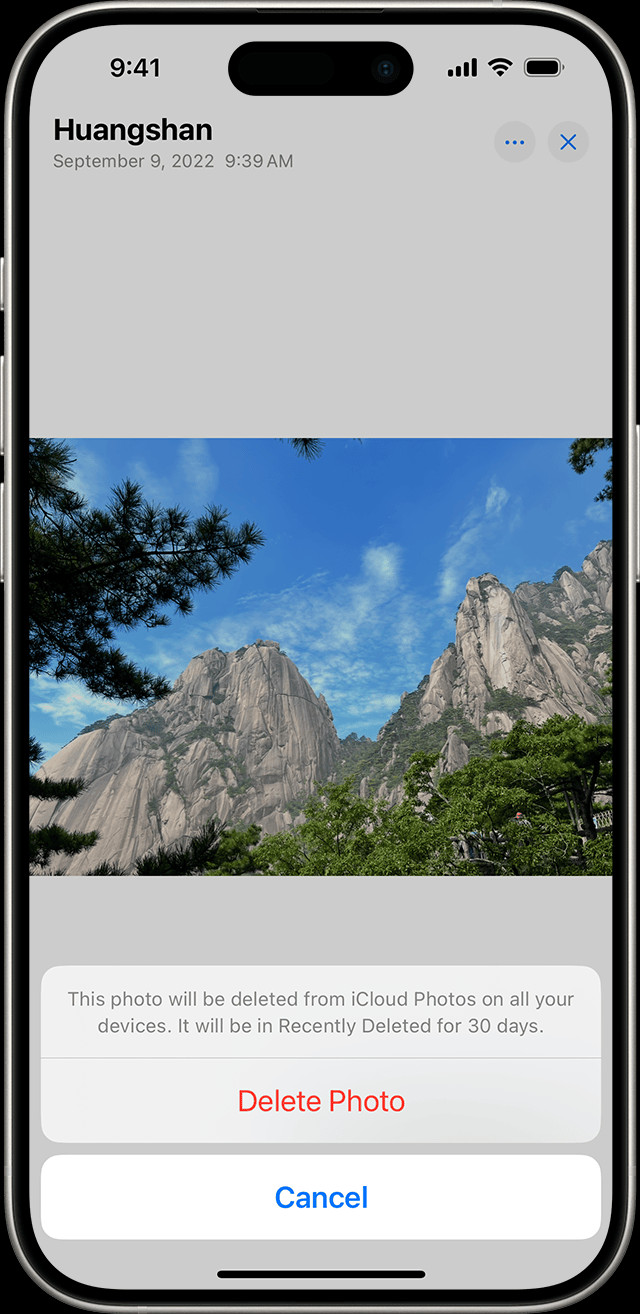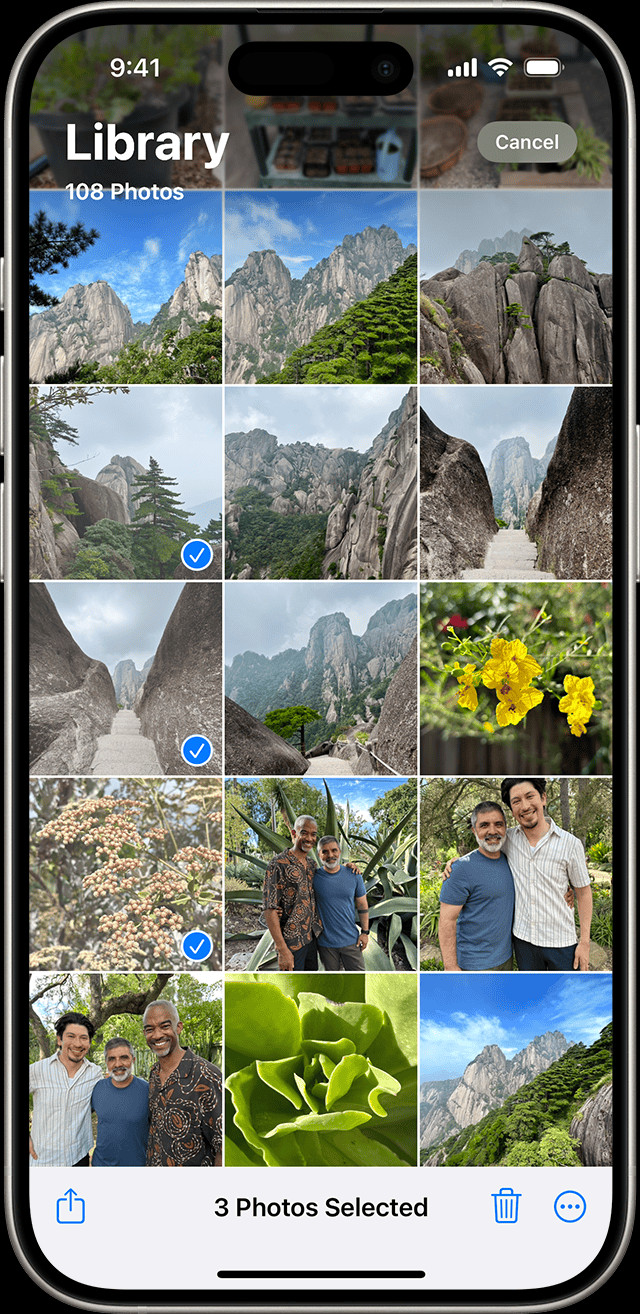The process of deleting photos from your iPhone can seem daunting, but it doesn’t have to be that way. Are you looking to free up space on your iPhone by removing unwanted images? At dfphoto.net, we’ll guide you through the straightforward steps of How To Select All Photos To Delete On Iphone, ensuring your device remains clutter-free and optimized for capturing new memories.
Whether you are a professional photographer or an amateur one, understanding how to manage your photos is important. It is essential to know how to delete your photos, and also how to optimize your photo storage. Keep reading to learn simple photo management.
Table of Contents
- Understanding Photo Management on iPhone
- Before You Begin: Backup Your Important Photos
- Methods to Select Multiple Photos for Deletion
- Deleting Photos in Batches
- Using iCloud Photos to Manage Storage
- Dealing with Duplicate Photos
- Recovering Accidentally Deleted Photos
- Permanently Deleting Photos from Your iPhone
- Managing Shared Photo Libraries
- Tips for Efficient Photo Management
- FAQ: Frequently Asked Questions
- Conclusion
1. Understanding Photo Management on iPhone
iPhone photo management involves a blend of techniques to keep your photo library organized and optimized. One thing to note is understanding how your iPhone stores photos and videos is crucial. iPhones offer a range of options, from local storage to iCloud integration, each impacting how you manage and access your media.
Local storage keeps your photos directly on your device, providing quick access but limiting space. According to Apple Support, managing your device’s photo storage efficiently involves regularly transferring photos to external devices or cloud services to free up space.
Cloud services like iCloud Photos sync your library across all your Apple devices. Deleting a photo on one device removes it from all synced devices. iCloud Photos offers convenience and backup but requires managing your iCloud storage effectively.
A hybrid approach combines local and cloud storage, keeping frequently accessed photos on your device while archiving others in the cloud. This balances accessibility with storage efficiency.
Understanding these storage options allows you to make informed decisions about how to manage, backup, and delete photos on your iPhone, ensuring your memories are safe and accessible while optimizing your device’s performance.
2. Before You Begin: Backup Your Important Photos
Before deleting photos on your iPhone, backing up your important pictures is an important step. This ensures that your memories are safe, even if you accidentally delete something you didn’t intend to. Here’s how you can back up your photos:
- iCloud: If you use iCloud Photos, your photos are automatically backed up to iCloud. Ensure that iCloud Photos is enabled in your iPhone settings (Settings > Photos > iCloud Photos). Make sure you have enough storage in your iCloud account to back up all your photos.
- Google Photos: Google Photos is another excellent cloud-based option. Download the Google Photos app, sign in with your Google account, and enable backup and sync. Google Photos offers free storage up to 15 GB, shared across your Google account.
- External Hard Drive: Connect your iPhone to your computer and transfer your photos to an external hard drive. This is a good option if you prefer having a physical backup of your photos.
- Computer: You can also back up your photos to your computer using iTunes or Finder (on macOS Catalina and later). Connect your iPhone, open iTunes/Finder, and follow the prompts to back up your device.
According to a study by the Santa Fe University of Art and Design’s Photography Department, backing up photos to multiple locations, such as iCloud and an external hard drive, provides an additional layer of protection against data loss.
 iPhone showing Delete Photo option
iPhone showing Delete Photo option
3. Methods to Select Multiple Photos for Deletion
Selecting multiple photos for deletion on your iPhone can be done efficiently using a few different methods.
-
Using the Select Button:
- Open the Photos app on your iPhone.
- Tap the Select button in the upper-right corner of the screen.
- Tap on each photo you want to delete. A checkmark will appear on the selected photos.
- Once you’ve selected all the photos, tap the Trash icon in the bottom-right corner.
- Confirm the deletion by tapping Delete [Number] Photos.
-
Sliding to Select:
- Open the Photos app.
- Tap Select in the upper-right corner.
- Tap and hold on the first photo you want to select, then slide your finger across the screen to select multiple photos quickly.
- Tap the Trash icon and confirm the deletion.
-
Using the Photos App Albums:
- Open the Photos app.
- Go to the album you want to manage (e.g., Recents, Screenshots).
- Tap Select.
- Select the photos you want to delete, or use the sliding method for faster selection.
- Tap the Trash icon and confirm the deletion.
Choosing the best method depends on the number of photos you need to delete and how they are organized in your library. For deleting a few photos scattered throughout your library, the tap-to-select method may be best. If you need to delete a large number of photos in a row, the sliding method can save time.
4. Deleting Photos in Batches
For users who want to clear out large portions of their photo library, deleting photos in batches is an important step. This process is more efficient than deleting photos one at a time.
-
Select and Delete: Follow the steps outlined in the previous section to select multiple photos. The iPhone allows you to select hundreds of photos at once, making this method suitable for clearing out significant portions of your library.
-
Using Albums for Organization: Organize your photos into albums based on date, event, or category. Then, you can quickly select and delete entire albums or large portions of them.
- Open the Photos app.
- Tap the Albums tab.
- Select the album you want to manage.
- Tap Select.
- Choose the photos you want to delete, or select all.
- Tap the Trash icon and confirm.
-
Regular Maintenance: Set aside time each month to go through your photos and delete unwanted images. This prevents your photo library from becoming overwhelmingly large.
According to insights from Popular Photography magazine, regularly organizing and deleting photos can also improve the performance of your Photos app, making it faster and easier to find the images you’re looking for.
5. Using iCloud Photos to Manage Storage
iCloud Photos is an important tool for managing your photo library and optimizing storage on your iPhone. By storing your photos in iCloud, you can access them from any device and free up space on your iPhone.
-
Enabling iCloud Photos:
- Open the Settings app on your iPhone.
- Tap Photos.
- Toggle iCloud Photos to the on position.
-
Optimize iPhone Storage:
- In the Photos settings, select Optimize iPhone Storage. This option automatically manages the size of your library on your device. Full-resolution photos and videos are stored in iCloud, while smaller, device-optimized versions are kept on your iPhone.
-
Managing iCloud Storage:
- Go to Settings > Your Name > iCloud > Manage Storage > Photos.
- Here, you can see how much storage your photos and videos are using.
- If you’re running out of space, you may need to upgrade your iCloud storage plan or delete some photos and videos.
-
Deleting and Syncing: When you delete a photo from your iPhone that is synced with iCloud Photos, it will be deleted from all your devices connected to the same iCloud account. Be careful when deleting photos to ensure you don’t accidentally remove something you want to keep.
iCloud Photos keeps your memories safe and accessible across all your devices, but you must manage your iCloud storage to avoid running out of space. Regularly reviewing and deleting unnecessary photos and videos is important to maintaining an organized and optimized photo library.
6. Dealing with Duplicate Photos
Duplicate photos can take up valuable storage space on your iPhone and make your photo library messy. iOS has built-in features to help you identify and merge duplicate photos, making it easier to manage your storage.
-
Using the Duplicates Album:
- Open the Photos app.
- Tap the Albums tab.
- Scroll down to the Utilities section and tap Duplicates. This album automatically identifies photos and videos that appear to be duplicates.
- Tap Merge to combine a set of duplicates. The iPhone will keep the highest quality version and move the duplicates to the Recently Deleted album.
- To merge multiple sets or all duplicates, tap Select, tap Select on each set, or tap Select All, then tap Merge.
-
Merging Duplicates:
- Tap Merge [Number] Items to confirm.
- When you merge duplicate photos, your iPhone combines the highest image quality and relevant data to keep one photo in your library. The other duplicate photos move to your Recently Deleted album.
According to Apple Support, the duplicates detection process happens automatically and may take some time. Ensure your iPhone is updated to at least iOS 16 for this feature to be available.
7. Recovering Accidentally Deleted Photos
Accidentally deleting photos happens, but iOS provides a safety net to recover these memories. The Recently Deleted album holds photos and videos for 30 days before they are permanently deleted, giving you time to restore them.
-
Accessing the Recently Deleted Album:
- Open the Photos app.
- Tap the Albums tab.
- Scroll down to the Utilities section and tap Recently Deleted.
- In iOS 16, iPadOS 16.1, or later, tap View Album, then use Face ID or Touch ID to unlock your Recently Deleted album.
-
Recovering Photos and Videos:
- Tap Select, then select the photo or video that you want to keep.
- Tap the Recover button. If you want to recover all the photos and videos in the album, tap Recover All.
- Tap Recover to confirm.
- When you recover photos and videos, they go back to your Library.
8. Permanently Deleting Photos from Your iPhone
After deleting photos, they remain in the Recently Deleted album for 30 days. If you want to permanently delete them and free up storage space immediately, follow these steps:
-
Open the Recently Deleted Album:
- Open the Photos app.
- Tap the Albums tab.
- Scroll down to the Utilities section and tap Recently Deleted.
- In iOS 16, iPadOS 16.1, or later, tap View Album, then use Face ID or Touch ID to unlock your Recently Deleted album.
-
Delete Photos Permanently:
- Tap Select, then select the photo or video that you want to delete.
- If you want to delete all the photos and videos in the album, tap Cancel, then tap Select again.
- Tap the Delete button, then tap Delete from All Devices or Delete Photos I Added to confirm.
- When you delete a photo or video from this album, you can’t get it back.
9. Managing Shared Photo Libraries
If you use iCloud Shared Photo Libraries, deleting photos works a bit differently. Shared Libraries allow you to share photos and videos with up to five other people, and anyone can add, edit, or delete items.
- Deleting from a Shared Library: If someone else deletes a photo or video from the Shared Library, it no longer appears for you, either.
- Recovering Deleted Items: Only the person who added the photo or video to the Shared Library can permanently delete or recover it from the Recently Deleted folder. You have 30 days to get a photo or video back from your Recently Deleted album.
- Managing Your Contributions: Be mindful of what you delete from a Shared Library, as it affects all members. Communicate with other members to ensure important photos are not accidentally deleted.
10. Tips for Efficient Photo Management
Efficient photo management involves more than just deleting unwanted photos. Here are some tips to help you keep your photo library organized and optimized:
- Regularly Review Your Photos: Set aside time each month to go through your photos and delete unwanted images. This prevents your photo library from becoming overwhelmingly large.
- Organize Photos into Albums: Use albums to categorize your photos based on date, event, or category. This makes it easier to find specific photos and manage large collections.
- Use iCloud Photos Efficiently: Enable iCloud Photos to sync your library across devices, and choose the Optimize iPhone Storage option to save space on your device.
- Delete Duplicate Photos: Regularly check the Duplicates album and merge duplicate photos to save storage space.
- Backup Your Photos: Back up your photos to multiple locations, such as iCloud, Google Photos, and an external hard drive, to protect against data loss.
- Use Third-Party Apps: Consider using third-party apps like Gemini Photos or Slidebox to help you identify and delete unwanted photos.
By implementing these tips, you can maintain an organized, efficient, and optimized photo library on your iPhone.
Come explore dfphoto.net for more tips and tricks on photo management and photography. Check out our extensive collection of beautiful photos and join our community of photography enthusiasts.
Address: 1600 St Michael’s Dr, Santa Fe, NM 87505, United States.
Phone: +1 (505) 471-6001
Website: dfphoto.net
 iPhone showing multiple photos selected in the Photos app
iPhone showing multiple photos selected in the Photos app
11. FAQ: Frequently Asked Questions
-
How do I select all photos to delete on my iPhone quickly?
To quickly select all photos for deletion, open the Photos app, tap Select, then drag your finger across the screen to select multiple photos at once.
-
What happens when I delete photos from my iPhone?
When you delete photos, they move to the Recently Deleted album for 30 days. After 30 days, they are permanently deleted.
-
How can I recover accidentally deleted photos on my iPhone?
You can recover accidentally deleted photos from the Recently Deleted album within 30 days of deletion.
-
How do I permanently delete photos from my iPhone?
To permanently delete photos, go to the Recently Deleted album, select the photos, and tap Delete.
-
Does deleting photos from my iPhone affect my iCloud storage?
Yes, deleting photos from your iPhone will affect your iCloud storage if you use iCloud Photos. Deleting a photo removes it from all devices synced with the same iCloud account.
-
How do I stop photos from syncing to iCloud?
To stop photos from syncing to iCloud, go to Settings > Photos and toggle iCloud Photos to the off position.
-
Can I delete photos directly from my iPhone if they were synced from my computer?
If you added photos to your iPhone by connecting it to your computer, you can’t delete them directly from your device in the Photos app. You need to stop syncing photos from your computer.
-
How do I manage duplicate photos on my iPhone?
Use the Duplicates album in the Photos app to identify and merge duplicate photos.
-
What is iCloud Shared Photo Library, and how does deleting photos work in it?
iCloud Shared Photo Library allows you to share photos with up to five other people. Anyone can delete items, but only the person who added the photo can permanently delete or recover it from the Recently Deleted folder.
-
How can I free up storage space on my iPhone?
To free up storage space, delete unwanted photos and videos, use iCloud Photos with Optimize iPhone Storage, and regularly check and merge duplicate photos.
12. Conclusion
Selecting and deleting all photos on your iPhone can be a straightforward process when you know the right steps. By following the methods outlined in this guide, you can efficiently manage your photo library, free up storage space, and keep your memories organized. Remember to back up your important photos before deleting them and take advantage of features like iCloud Photos and the Duplicates album to optimize your photo management.
For more photography tips, tricks, and inspiration, visit dfphoto.net today. Explore our resources to enhance your photography skills and discover the beauty of visual storytelling. Whether you’re looking for tutorials, gear reviews, or a community of fellow photographers, dfphoto.net is your ultimate resource. Join us and take your photography to the next level!
